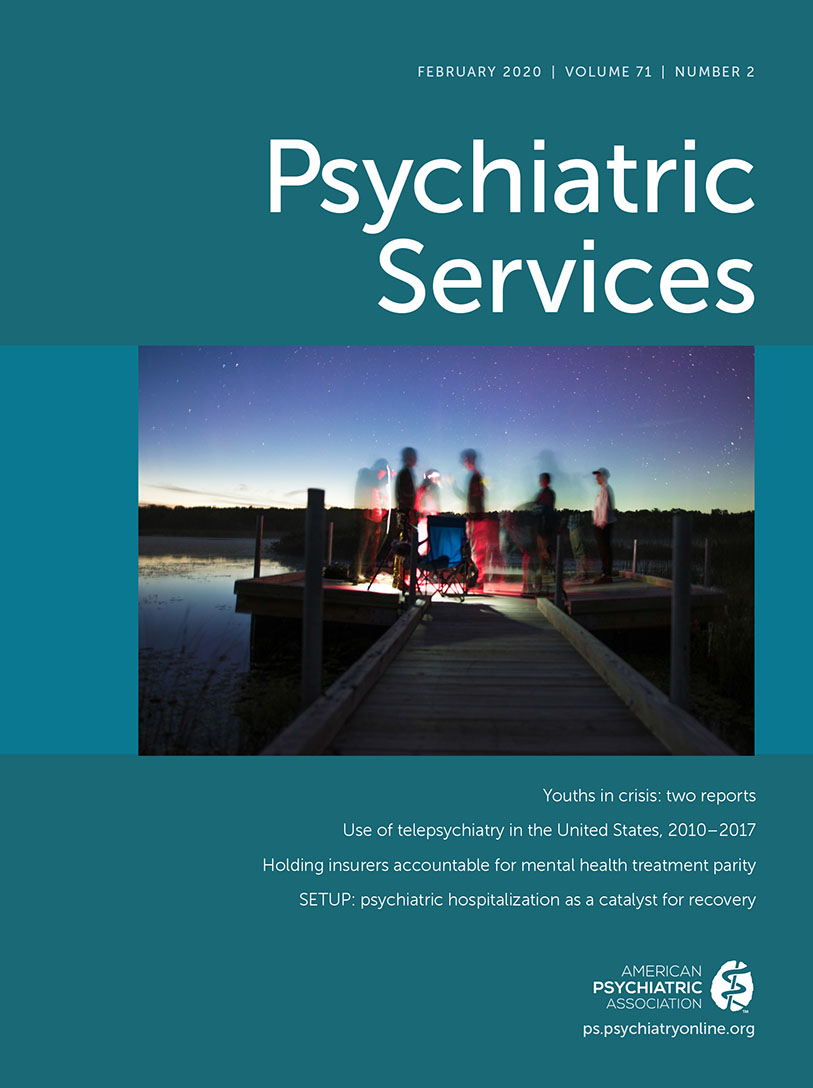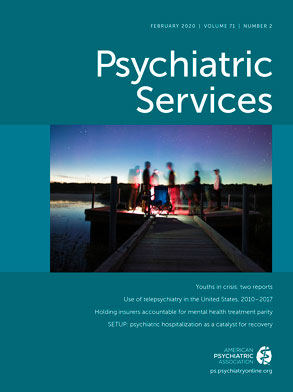Approximately 2.4 million adults in the United States (1.0% of all adults) are living with chronic hepatitis C virus (HCV) (
1), and rates are three times higher among U.S. veterans (
2). The prevalence of HCV is especially elevated for veterans with serious mental illness (schizophrenia, bipolar disorder, recurrent major depression, chronic posttraumatic stress disorder). Veterans with serious mental illness are three to four times more likely to have HCV (
3) because of a greater clustering of HCV risk factors (e.g., substance abuse, sexual risk behavior) (
3,
4). Historically, individuals with serious mental illness are less likely to be screened, tested, and treated for HCV (
3,
4).
The introduction of HCV medications dramatically reduced mortality rates related to the virus. Interferon, the first HCV medication, involved a complex regimen (
5) that resulted in low cure rates (50%–70%) and serious psychiatric side effects (e.g., depression, suicidal ideation) (
2,
5,
6). Many providers did not initiate interferon treatment for individuals with serious mental illness because the medication required intensive monitoring of psychiatric symptoms and provoked concerns about treatment nonadherence in this population (
3,
6,
7).
Sofosbuvir, the first direct-acting antiviral medication, addressed many of these barriers. Sofosbuvir can achieve sustained virologic response in 90%–100% of patients within 8–12 weeks (
8,
9) and produces minimal psychiatric side effects (
5,
10). Unfortunately, access to direct-acting antivirals at the population level requires substantial financing, given that the typical daily dose (400-mg pill) costs $1,000, totaling $56,000 for an 8-week course (
8). In fiscal year (FY) 2016, the Veterans Health Administration (VHA) received $1.5 billion in supplemental funding to allow any veteran in the VHA health care system with an HCV infection access to direct-acting antivirals, specifically sofosbuvir-based regimens, at no cost (
11), eliminating financial barriers to HCV treatment for this population.
Using VHA administrative data, Barnett and colleagues examined disparities in access to direct-acting antiviral treatment (
12). They found a sevenfold increase in use of direct-acting antiviral HCV treatments in the U.S. Department of Veterans Affairs (VA) health care system during FY 2000–2014; however, veterans with substance use disorders and with schizophrenia spectrum disorders were less likely to be prescribed direct-acting antivirals. Veterans with other mental health conditions (e.g., mood disorders, posttraumatic stress disorder) were as likely to receive direct-acting antivirals as veterans without these disorders (
12). Notably, the Barnett study preceded the expanded VHA funding for direct-acting antivirals. Results from recent non-VA analyses involving small clinical samples suggest that individuals with serious mental illness were just as likely to access direct-acting antiviral medication and achieve similar sustained virologic response (
10).
This study examined sofosbuvir-based treatment initiation and completion in a large sample of veterans receiving care from VA facilities in the Mid-Atlantic service region. Initiation and completion rates may be influenced by several factors. Historical inequities that resulted in limited access to interferon-based HCV care among individuals with serious mental illness might persist and result in less access to sofosbuvir-based HCV treatment. Also, veterans with serious mental illness who have substance dependence and other clinical complexities might be less likely to complete the recommended 8- to 12-week course of treatment. To our knowledge, mental health–related disparities in direct-acting antiviral completion rates have not been studied previously in the VA or elsewhere. We hypothesized that veterans with serious mental illness would be both less likely to start and less likely to complete ≥8 weeks of sofosbuvir-based treatment compared with veterans without serious mental illness.
Methods
This study used VHA administrative data from FY 2016–2017 from the VA’s mid-Atlantic integrated service network. In FY 2016, 4,288 veterans were identified as HCV treatment naïve. We obtained prescription data for HCV medications filled at VA pharmacies during FY 2016–2017 in order to examine a full course of treatment for these veterans. Veterans who received a direct-acting antiviral medication other than sofosbuvir-based regimens (N=171, 4%) were excluded because these medications were only available for part of FY 2016. The remaining 4,117 veterans were grouped into those who received sofosbuvir-based regimens (in combination with daclatasvir, esbasvir/grazoprevir, ledipasvir, or ribavirin and velpatasvir) (N=1,311, 31%) and those who did not receive any HCV medications (N=2,806, 65%).
Logistic regression was used to compare sofosbuvir-based treatment initiation among veterans with and veterans without serious mental illness. Covariates included age, race, gender, VA service-connected disability rating of ≥50% (no prescription copays), homelessness, and opioid and alcohol use disorders. We used the same logistic regression model specification to estimate whether a recommended course of sofosbuvir-based therapy was completed, and we operationally defined completion per VA treatment recommendations (
9) as receiving ≥8 weeks of sofosbuvir-based medication. Although the recommended duration of direct-acting antiviral treatment depends on many factors, including treatment history, HCV genotype, viral load, and comorbidities (e.g., cirrhosis, HIV), we modeled 8 weeks of treatment, because previous work has shown that this duration is sufficient for many patients to achieve sustained virologic response (
9,
13). All analyses were completed in SAS version 9.4. The study was approved by the University of Maryland School of Medicine Institutional Review Board and related VA research oversight committees.
Results
Estimates of adjusted odds ratios are reported for both logistic regression analyses in
Table 1. In total, 30% (N=549) of veterans with serious mental illness and 31% (N=762) of those without serious mental illness initiated sofosbuvir-based treatment (p=0.169). Having a serious mental illness did not differentiate veterans’ rate of initiating sofosbuvir (p=0.628). Black/non-Hispanic (p<0.001) and male (p=0.021) veterans were more likely to receive sofosbuvir, and individuals with ≥50% service connection were less likely to receive sofosbuvir (p=0.013).
Among the 1,311 veterans who initiated sofosbuvir-based treatment, 95% (N=1,248) received ≥8 weeks of their prescribed medication. In the logistic regression analysis, veterans with serious mental illness were as likely to receive ≥8 weeks of a sofosbuvir-based regimen as those without serious mental illness (p=0.301). Only age and alcohol use disorder emerged as significant covariates: older veterans were more likely to receive ≥8 weeks of sofosbuvir-based treatment compared with veterans under age 45 (p<0.001), and individuals with an alcohol use disorder were less likely to receive ≥8 weeks of medication (p=0.011).
Discussion
In FY 2016, the VA received $1.5 billion in supplemental funding to expand veterans’ access to sofosbuvir-based regimens and other direct-acting antiviral medications in order to treat HCV (
11). Overall, 31% (N=1,311) of the HCV treatment-naïve veterans in our sample initiated sofosbuvir-based regimens during FY 2016. These initiation rates are higher than what was reported prior to the VHA’s expanded funding: Barnett et al. found that 18.1% of veterans initiated direct-acting antiviral treatment in FY 2015 (
12). Of those who initiated sofosbuvir-based treatment in our study, the vast majority (N=1,248, 95%) received enough medication to complete ≥8 weeks of treatment.
Within the VA health care facilities included in this study, access to sofosbuvir-based regimens was equitable with respect to serious mental illness. This finding is consistent with prior research among non-VA samples of individuals with serious mental illness (
10). However, it only partially aligns with the finding reported by Barnett et al. (
12) that the rate of HCV treatment was lower for veterans with psychotic disorders but not for veterans with mood disorders and posttraumatic stress disorder. This discrepancy might be related to the difference in the time frames assessed in the two studies (before versus after expanded HCV treatment funding), or it might reflect that VA facilities that were included in this study are not representative of other facilities nationwide. Additionally, the simpler and shorter treatment regimen of direct-acting antivirals and their minimal psychiatric side effects may have resulted in greater provider confidence treating HCV in individuals with serious mental illness.
Other findings include evidence of higher rates of HCV treatment initiation with sofosbuvir-based regimens among black veterans and lower rates of HCV treatment initiation among female veterans and veterans with ≥50% service connection status. Most veterans in our sample were black, and our results suggest that veterans visiting Mid-Atlantic VA facilities were not disadvantaged in access to HCV treatment—a positive step given the historically documented treatment disparities for black individuals. It may be important to direct greater attention to the specific treatment needs of female veterans, a growing subgroup in the VA system, especially because this study found that they are less likely to initiate sofosbuvir treatment in VA. Copays and other out-of-pocket treatment costs have been cited as potential barriers to treatment (
8), but little evidence suggests they affected access to HCV care at the VA facilities examined during the study period. It is plausible that the expanded, fully funded HCV treatment initiative in the VHA contributed to a reduction in both racial and socioeconomic barriers to treatment.
Further, younger veterans and those with an alcohol use disorder were less likely to complete an 8-week course of sofosbuvir-based treatment. Younger veterans might be less accustomed to taking daily medications and may therefore demonstrate lower medication adherence compared with older veterans. Furthermore, previous literature has identified drug abuse and alcohol abuse as additional HCV risk factors in populations with serious mental illness and noted that they can be associated with low rates of treatment initiation and adherence (
3,
4).
Despite many advantages of direct-acting antivirals, supporting medication adherence continues to be a critical component of HCV treatment. Specialized service-system supports (e.g., case managers, peer mentors) and multidisciplinary teams can promote adherence among individuals with an increased propensity for early discontinuation (
14). During this study, at least one facility in the region had an infectious disease clinic consisting of a multidisciplinary team that provided comprehensive services, including treatment readiness evaluations, directly observed therapy, and case management in order to enhance HCV treatment outcomes and address patient needs. The presence of these services in at least a portion of the region we studied may explain the generally high rates of completion of sofosbuvir-based regimens. However, not all facilities offered such strong interdisciplinary supports, and not all veterans with access to them may have used the services. Other research suggests that encouraging patient engagement in specialty mental health care and substance use treatment, including incorporating HCV screening and referrals within these settings, can enhance the overall success of HCV treatment (
15). Future research should further examine patients’ level of engagement with comprehensive HCV treatment services and its effect on direct-acting antiviral initiation and completion rates.
This study benefited from a large sample size, the racial diversity of the sample, and its setting in a region known to have higher than average rates of HCV (
7). However, some limitations should be noted. The study’s findings that access to sofosbuvir-based treatment was similar for veterans with and veterans without serious mental illness may not generalize to other VA facilities. One facility in this region had implemented specialized system capacities—which may not be widely available in other VA facilities—for identifying and treating HCV in high-risk groups. Second, this study’s findings may not generalize to non-VA systems of care, because the VHA continues to receive supplemental federal funding to provide access to sofosbuvir-based regimens and other direct-acting antiviral medications. Third, we did not have information on certain factors that determine the length of direct-acting antiviral treatment (e.g., HCV genotype, comorbid conditions). Finally, although 8 weeks of sofosbuvir treatment is effective in more than 90% of HCV cases, we did not know which veterans achieved a sustained virologic response following treatment.
Conclusions
During a period of expanded VA financing for direct-acting antiviral therapies for HCV, we found that veterans with HCV infection and serious mental illness began and completed sofosbuvir-based treatment in similar proportion to veterans without a serious mental illness, when controlling for other factors (e.g., demographic characteristics, homelessness, substance use). Findings suggest that newer direct-acting antiviral medications, expanded funding to cover the cost of direct-acting antiviral medications within the VHA, VA provider training initiatives, and multidisciplinary supports likely contribute to greater equity in access to HCV treatment among veterans with mental health conditions.

